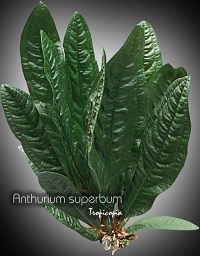Table of contents
Bronze Anthurium

Latin Name: Anthurium superbum
Category: Anthurium
Family: Araceae
Origin: Ecuador
Climate: Tropical
Growing Zones: 12
Care Instructions
The Bronze Anthurium (Anthurium superbum) is a tropical plant that originates from Ecuador. This anthurium plant belongs to the Araceae family and is well-suited for growing in USDA zones 12.
Complete Care Guide for Bronze Anthurium (Anthurium superbum)
Watering Requirements
The Bronze Anthurium, known for its striking foliage and unique flower structure, requires careful attention to its watering needs. It thrives in a consistently moist environment, but it is crucial to avoid overwatering, which can lead to root rot. Water the plant when the top inch of soil feels dry to the touch. During the growing season (spring and summer), you may need to water more frequently, approximately once a week, while in the dormant season (fall and winter), reduce watering to every two weeks. Always ensure that the pot has drainage holes to allow excess water to escape, and consider using distilled or rainwater, as Anthuriums can be sensitive to chemicals found in tap water.
Light Conditions
Bronze Anthuriums prefer bright, indirect light to thrive. Direct sunlight can scorch their leaves, leading to unsightly brown patches and stunted growth. Ideally, place your Anthurium near a window that receives filtered light or in a well-lit room where it can enjoy bright, indirect sunlight for most of the day. If you notice the plant stretching towards the light or the leaves losing their vibrant color, it may be a sign that it needs more light. Conversely, if the leaves are turning yellow, it might be receiving too much direct sunlight. Adjusting its position accordingly will help maintain its health and vibrancy.
Soil Preferences
The ideal soil for Bronze Anthurium is a well-draining potting mix that retains some moisture without becoming waterlogged. A blend of peat moss, perlite, and orchid bark works exceptionally well, providing the necessary aeration and drainage. This combination allows the roots to breathe while still holding enough moisture to keep the plant hydrated. Additionally, consider fertilizing your Anthurium every 4-6 weeks during the growing season with a balanced, water-soluble fertilizer diluted to half strength. This will promote healthy growth and vibrant blooms. In the fall and winter, reduce fertilization as the plant enters its dormant phase.
Pests and Diseases
While Bronze Anthuriums are relatively resilient, they can still fall victim to common pests such as aphids, spider mites, and mealybugs. Regularly inspect the undersides of leaves and the stems for any signs of infestation. If you notice pests, treat the plant with insecticidal soap or neem oil, ensuring to cover all affected areas. Additionally, watch for signs of fungal diseases, which can occur if the plant is overwatered or in overly humid conditions. Yellowing leaves, wilting, or black spots can indicate a fungal issue. To prevent this, ensure proper air circulation around the plant and avoid overhead watering. If disease occurs, remove affected leaves and treat with a fungicide as necessary.
Special Care Tips
To keep your Bronze Anthurium thriving, consider a few special care tips. First, maintain humidity levels around 60-80%, as these tropical plants flourish in humid environments. You can achieve this by misting the leaves regularly, using a pebble tray filled with water, or placing a humidifier nearby. Additionally, repot your Anthurium every 2-3 years to refresh the soil and provide more space for growth. When repotting, choose a pot that is only slightly larger than the current one to prevent overwatering issues. Lastly, be patient with flowering; while Anthuriums can bloom year-round under ideal conditions, it may take time for your plant to produce flowers, especially if it is still establishing itself. With the right care, your Bronze Anthurium will reward you with its stunning foliage and occasional blooms, making it a beautiful addition to your indoor garden.








